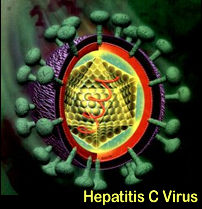Nitazoxanide
plus Pegylated Interferon and Ribavirin Produces Virological
Response in Some Prior Non-responders with Cirrhosis
 |
 |
 |
 |
 |
 |
 |
| SUMMARY:
According to interim results of a small study
presented at the 60th Annual Meeting of the American
Association for the Study of Liver Diseases (AASLD)
in Boston last week, genotype 1 chronic hepatitis
C patients with liver
cirrhosis who did not respond to prior treatment
with pegylated
interferon alfa-2a (Pegasys) plus ribavirin
experienced promising virological responses to
triple combination therapy with pegylated interferon,
ribavirin, and nitazoxanide. Nearly half (46%)
of study participants achieved early virological
response (EVR) at week 12 and 15% achieved undetectable
viral load; however, only 1 out of 9 African-Americans
achieved EVR. |
|
 |
 |
 |
 |
 |
 |
 |
 Nitazoxanide
-- a member of a class of small molecules known as thiazolides
-- is a potent inhibitor of hepatitis C virus (HCV). Previous
studies in HCV genotype 4 patients indicated that nitazoxanide
may enhance sustained virological responses (SVR) with
no serious adverse events.
Nitazoxanide
-- a member of a class of small molecules known as thiazolides
-- is a potent inhibitor of hepatitis C virus (HCV). Previous
studies in HCV genotype 4 patients indicated that nitazoxanide
may enhance sustained virological responses (SVR) with
no serious adverse events.
Nitazoxanide is currently in Phase 2 clinical development
for hepatitis C treatment. The pilot study presented at AASLD
was conducted to assess the antiviral activity of lead-in
nitazoxanide administered with pegylated
interferon alfa-2a (Pegasys) plus ribavirin for treatment-experienced
cirrhotic genotype 1 patients who experienced previous treatment
failure.
The
study included 14 participants (13 prior non-responders
and 1 relapser). All but 1 were men, the average was 57
years, 9 were African-American, and 5 were white. Individuals
with hepatitis A, B, or other forms of liver disease, hepatocellular
carcinoma, HIV,
pre-existing severe depression or other uncontrolled psychiatric
disease, and significant kidney, cardiac, neurological,
or other central nervous system disorders were excluded.
Participants
received 500 mg twice-daily nitazoxanide for 4 weeks, followed
by nitazoxanide plus 180 mcg/week pegylated interferon and
weight-adjusted ribavirin for 48 weeks. Patients who did
not achieve EVR (at least a 2 log decrease in HCV RNA) by
week 12 and/or had detectable HCV RNA at 24 weeks discontinued
the study.
Results
 |
Overall,
50% of participants achieved EVR at week 12 (see table). |
 |
14.3%
had undetectable HCV RNA at week 12 (see table). |
 |
By
week 48, all patients had undetectable viral load. |
 |
Only
1 of 9 blacks achieved EVR, compared with all 5 whites. |
 |
Overall,
nitazoxanide combination therapy was well tolerated,
without early discontinuation. |
 |
No
serious adverse events were reported throughout the
study. |
 |
Four
patients developed adverse events including diarrhea
(3), cellulitis (3), rash (2), and laryngitis (1). |
 |
These
events were mild-to-moderate and intermittent, with
none leading to treatment discontinuation. |
 |
Due
to neutropenia and neutropenia, 3 patients required
dose reductions for Peg-IFN/R. |
 |
Five
patients (without EVR) discontinued therapy due to lack
of response. |
| Treatment |
NTZ
(N=14)
|
NTZ+PegIFN+R
(N=14) (N=13) (N=7) (N=2)
|
| Duration
of Rx (weeks) |
4
|
4+4
|
4+12
|
4+24
|
4+48
|
| %
EVR (>2 log decrease in HCV RNA) |
0
|
14%
|
50%
|
60%
|
100%
|
| %
with undetectable HCV RNA |
0
|
7%
|
14%
|
40%
|
100%
|
| Average
log decrease in HCV RNA |
0.17
|
1.4
|
2.4
|
3.4
|
5.9
|
NTZ
= nitazoxanide; PegIFN = pegylated interferon; R = ribavirin.
Based
on these findings, the investigators concluded, "An
interim analysis of this study indicates that treatment
[of HCV genotype 1 patients] with lead-in nitazoxanide in
combination with pegylated interferon and ribavirin has
demonstrated promising results in these difficult to treat
patients."
11/10/09
References
B Yoffe, K Gasitashvili, and V Khaoustov. Pilot study of
lead-in nitazoxanide plus pegylated alpha-2a interferon
and ribavirin in HCV-genotype 1 nonresponders with cirrhosis:
interim results. 60th Annual Meeting of the American Association
for the Study of Liver Diseases (AASLD 2009). Boston. October
30-November 1, 2009. Abstract 1580.